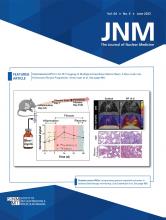TO THE EDITOR: We read with interest the recent pilot study by Wetherill et al. (1). The authors used 18F-6-(1/2)(2-fluoropropyl)-4-methylpyridin-2-amine (18F-NOS) PET imaging to quantify inducible nitric oxide synthase expression to characterize oxidative stress and inflammation in the lungs of 5 electronic cigarette (EC) users, 5 tobacco cigarette (TC) smokers, and 5 controls who had never smoked or vaped. PET imaging showed much greater 18F-NOS nondisplaceable binding potential in the lungs of EC users than in TC smokers, but contrary to expectations, no difference between TC smokers and controls was found.
The reported absence of difference in 18F-NOS nondisplaceable binding potential between TC smokers and controls is inconsistent with the suggestion given by enhanced nondisplaceable binding potential on 18F-NOS imaging that there is oxidative stress and inflammation in the lungs, given that smoking causes both inflammatory responses and oxidative stress. This issue renders interpretation of the study’s findings invalid. In consideration of the very small sample size and low reproducibility of 18F-NOS PET imaging, the likelihood of chance findings is very high. There would have been more confidence in the interpretation if former smokers had been included in the study design; however, this was not done. Important confounders, such as allergies of the upper respiratory tract with inducible nitric oxide synthase upregulation and high levels of exhaled nitric oxide (2) and prior and present exposure to tobacco smoking among EC users (3)—who are typically either former smokers or dual users—were not taken into consideration. As it is impossible to decouple the lung health impact of EC aerosol emissions from prior tobacco smoke exposure, only long-term follow-up of exclusive EC users who have never smoked TCs in their life would have been a better-suited study design to verify potential harm caused by EC use. In a 3.5-y prospective clinical trial, daily exclusive EC users who had never smoked TCs did not exhibit any increase in exhaled nitric oxide (4).
Additionally, given the cross-sectional design of the study, the observed correlation between EC use and improved 18F-NOS PET imaging does not infer causation.
The results of the study are inconsistent with the evidence that cigarette smoking reduces, not increases, inducible nitric oxide synthase expression and NO production from lung epithelial cells (5), as well as with the evidence that smoking is consistently linked to low levels of exhaled nitric oxide that return to normal after smoking is stopped (6–8).
Therefore, this pilot study does not support the argument that vaping is more harmful than smoking, and it contradicts clinical evidence showing that ECs may have some benefits in minimizing the harm caused by cigarette smoke and are unlikely to cause serious respiratory issues (3,4,9).
DISCLOSURE
Riccardo Polosa has received grants from U-BIOPRED, AIR-PROM, the Integral Rheumatology and Immunology Specialists Network (IRIS), the Foundation for a Smoke Free World, Pfizer, GlaxoSmithKline, CV Therapeutics, NeuroSearch A/S, Sandoz, Merck Sharp & Dohme, Boehringer Ingelheim, Novartis, Arbi Group Srl., Duska Therapeutics, Forest Laboratories, and Ministero dell’Università e della Ricerca (MUR) Bando PNRR 3277/2021 (CUP E63C22000900006) and 341/2022 (CUP E63C22002080006), funded by NextGenerationEU, the European Union (EU) economic recovery package. He is founder of the Center for Tobacco Prevention and Treatment (CPCT) at the University of Catania and of the Center of Excellence for the Acceleration of Harm Reduction at the same university. He receives consultancy fees from Pfizer, Boehringer Ingelheim, Duska Therapeutics, Forest Laboratories, CV Therapeutics, and Sermo Inc. He is being paid textbook royalties from Elsevier. He is also involved in a patent application for ECLAT Srl. He is a pro bono scientific advisor for Lega Italiana Anti Fumo (LIAF) and the International Network of Nicotine Consumers Organizations (INNCO), and he is the chair of the European Technical Committee for Standardization on “Requirements and Test Methods for Emissions of Electronic Cigarettes” (CEN/TC 437; WG4). Stefano Palmucci has received personal consulting fees or speaker fees from Boehringer Ingelheim and F. Hoffmann La Roche Ltd. outside the submitted work; is working in the scientific committee of the research project RF 2019-12371462 “Model for Optimized Implementation of Early Lung Cancer Detection: Prospective Evaluation of Preventive Lung Health,” promoted by “Ministero della Salute” (Italy); has received consultancy fees from Elma Research srl (Milano, Italy); and has received support from Bracco Imaging SpA and Bayer Schering for congress registrations and congress accommodations/travels. No other potential conflict of interest relevant to this article was reported.
Footnotes
Published online May 11, 2023.
- © 2023 by the Society of Nuclear Medicine and Molecular Imaging.
REFERENCES
- Received for publication February 2, 2023.
- Revision received February 2, 2023.
- Accepted for publication February 7, 2023.







